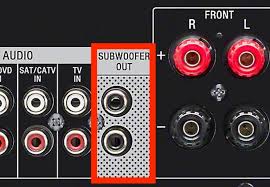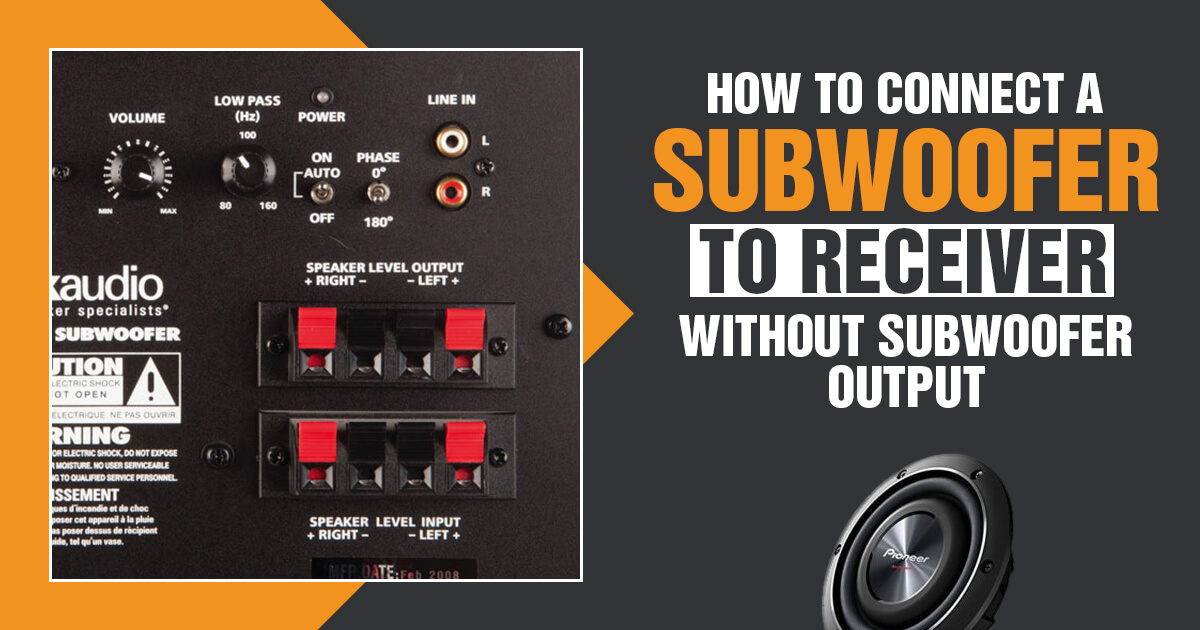The simple answer is that there are a few ways to connect a subwoofer to the receiver. Before you get started, you must first note:
- What kind of subwoofer you own.
- What kinds of AV receiver outputs you can make use of.
- Which kinds of subwoofer inputs you have available to you.
But let’s not get ahead of ourselves.
Tell me if this sounds familiar. You buy a fancy new subwoofer, ready to open your living room to a world of low-level base it has never seen before.
It may feel like the end of the world, especially if you think you are going to be forced to shell out on a brand-new AV receiver.
Don’t worry if it does, you are not alone. In fact, it is a position I found myself in recently. The good news is that, after a few hours of stress-fuelled googling, I was relieved to find out that all hope isn’t lost.
You will be glad to hear that there are a couple of ways to connect your new subwoofer to a receiver without a SUB-OUT connection.
After analyzing which connections are available to you, we will cover three potential methods for doing so. One of these is bound to apply to your current predicament:
- Connecting a passive sub with an external amplifier.
- Connecting an active sub via Stereo RCA output.
- Connecting an active sub via Speaker Level Inputs.
How To Connect Subwoofer To Receiver Without Subwoofer Output
Determining which kind of subwoofer you are working with:
Before we look at which connections to use, we first need to establish which kind of subwoofer we are working with. There are two common types of a stereo subwoofer: powered (or “active”) and non-powered (or “passive”):
- Active subwoofers are the most common type. An active subwoofer contains a built-in amplifier. This gives you a lot more flexibility in getting it connected to your receiver, as it won’t also need to be powered through that connection.
- Passive subwoofers act more like traditional speakers. They need to be powered by either an external amplifier or draw power from your AV receiver. It is unusual to come across a passive subwoofer nowadays, as they are far less common than they used to be.
It is usually easy to tell the two apart. An active subwoofer will generally be much larger and produce a far louder sound.
It will take a few more steps to get a passive subwoofer connected without a subwoofer output, so keep reading for more details.
Determining the best alternative connection to use:
For most, determining how best to connect your subwoofer to your receiver is easy. You simply plug it into the connection clearly labeled “Subwoofer”, “Subwoofer Out”, or “Sub Out”.
Some websites and blogs claim that if you don’t have a ‘Subwoofer Output’ on your receiver, you will need to go buy a new one.
That’s a bunch of baloney. In truth, you have a couple of other options available to you, based on your type of subwoofer and which outputs your receiver supports.
Connecting with stereo RCA connectors:
Almost all receivers that do not have subwoofer outputs will have preamp outputs that you can use instead.
If your subwoofer comes with Left and Right (L; R) stereo connectors, you can use these to start enjoying those sweet low tones.

To do so, follow these simple instructions:
- Grab a set of RCA cables. If your subwoofer has only one RCA input, you may also need an RCA Y-Adapter.
- Plug the male ends of your cables into your subwoofer input and the two female ends into your preamp output from the receiver.
- If your subwoofer has only one RCA input, plug in the Y-Adapter, effectively turning a single input into two and allowing you to make use of both channels.
This avoids completely the need for a Subwoofer Output in your AV receiver.
However, this method does require that both your subwoofer line-in and receiver line-out use RCA cables. If your sub doesn’t have RCA inputs, you will need to connect it to your Receiver like a regular speaker.
Connecting with Speaker Level Outputs:
If you can’t connect the two with RCA cables, it is time to think about using speaker-level (or ‘high-level’) outputs.
Look at the back of your receiver for spring clip connectors, like those you would find on the back of a regular speaker. Using these, you can plug in your subwoofer as if it were a normal speaker.
To do so, follow these simple instructions:
- Run your speaker wires from your AV receiver to the back of your subwoofer.
- Connect the left and right terminals of your receiver’s spring clip connectors.
- Connect the left and right terminals of your subwoofers spring clip connectors.
Be careful, though. Your sub may have two sets of spring clips: one titled “speaker in” and the other “speaker out”. These allow you to run your speakers through your sub, allowing you to connect both to single receiver speaker-level outputs. Be sure to connect to the right ones!
If your subwoofer has only one set, this means you will need to use the same set of connections for both your speakers and your subwoofer.
Finally, a small minority of subwoofers won’t have speaker-level inputs. Nonetheless, it is a useful addition in case your subwoofer doesn’t have any preamp inputs.
Connecting a Passive Subwoofer with an External Amplifier:
There are a couple of ways to connect an active subwoofer. But your options are more limited if you own a passive subwoofer. This is because you will need to install an intermediary amplifier to prevent draining power from your receiver.
A receiver can provide signals to your passive subwoofer, but it will struggle to deliver the power necessary for it to function properly.
For this reason, we recommend getting your hands on an external amplifier. This will essentially turn your passive subwoofer into an active one, allowing you to connect it via one of the methods detailed above. Simply sub-in the newly attached amplifier for the back of your subwoofer.
Choosing not to buy an external amplifier is to risk (dramatically) inferior sound quality from your subwoofer. It also risks drawing too much power from your AV receiver. This might force you to suffer through an all-around worsening of your stereo system experience.
If you prefer to watch an instructional video instead, I have one for you below.
Frequently Asked Questions
Why do some receivers not have a Subwoofer Output? Are they still compatible with my new subwoofer?
It isn’t that a few AV receivers, pre-amps, and amplifiers here and there lack dedicated subwoofer output jacks. Most AV receivers do not have one, nor do they offer explicit bass-management options.
Take comfort: you are not alone in looking for alternative ways to hook your new subwoofer up.
Yes, subwoofers are still compatible, even if you do not have a subwoofer output on your AV receiver or pre-amp. They are still recommended for the best audio experience for music or cinema.
Should I expect inferior quality without a Subwoofer Output connection?
Despite the name, the Sub Out connection on the back of your receiver is not necessarily the most effective way to hook up your subwoofer.
Some argue that connecting a subwoofer via high-level inputs will deliver superior sound quality to any other method. Here are a few reasons why:
- Your subwoofer will be receiving the same signal as your other speakers, eliminating any timing differences or lag.
- Your subwoofer will receive a more textures bass signal. Thus, allowing for a noticeable improvement in accent and articulation of bass notes, particularly as you listen to music.
What are the main benefits of installing a subwoofer?
The main benefit of adding a subwoofer to your home stereo system is that it adds depth and richness to both music and cinematic sound effects. Without one, it can seem as if the sound is “canned” or “tinny”.
The primary purpose of a sub is to focus on delivering quality bass tones. It can do this in a way no other can, specifically designed to deliver deep, rich low-frequency tones. This doesn’t just make sound effects and music sound deeper and richer, it can also help bring together your sound system.
For these reasons, a subwoofer won’t just make your stereo system sound better, it will also make it feel deep, rich, and comprehensive.
Final Verdict on How to connect subwoofer to a receiver without a subwoofer output
We’ve all been there. Stuck with a new subwoofer and no sub-out jack, you might have to shell out hundreds of dollars for a new AV receiver.
Luckily, no matter which type of sub you own and which connections are available to you, there are ways to get your new speaker wired up and emitting exceptional quality:
- If you have a passive subwoofer, you can connect it to your receiver via an external amplifier.
- If you have an active subwoofer, you can connect it to your receiver via either your Stereo’s RCA output or your Speaker’s Level Inputs.
This could save you the few hundred dollars you would have otherwise spent on a new receiver, and/or the accessories you may have purchased to get everything connected.
Best of all, you can expect very little in the way of sound quality interference, making these great options for getting the most out of your brand-new subwoofer.

